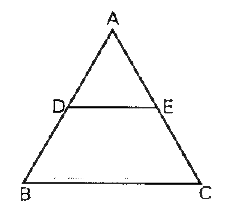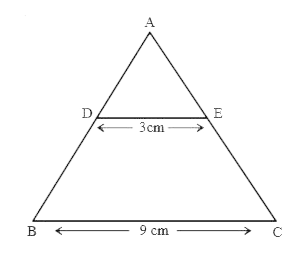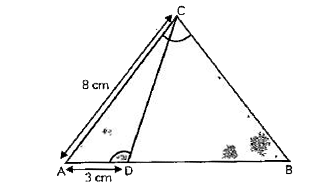In the given figure, AD = 2cm, BD = 3 cm, AE = 3.5 cm and AC = 7 cm. Is DE parallel to BC ?

Video Solution
|
Answer
Step by step video & image solution for In the given figure, AD = 2cm, BD = 3 cm, AE = 3.5 cm and AC = 7 cm. Is DE parallel to BC ? by Maths experts to help you in doubts & scoring excellent marks in Class 10 exams.
Updated on:21/07/2023Topper's Solved these Questions
- MATHEMATICS BASICBOOK - CBSE MODEL PAPERCHAPTER - MATHEMATICS BASICEXERCISE - PART A (SECTION -II)
20 Videos
- MATHEMATICS BASICBOOK - CBSE MODEL PAPERCHAPTER - MATHEMATICS BASICEXERCISE - PART B
21 Videos
- Additional Practice QuestionsBOOK - CBSE MODEL PAPERCHAPTER - Additional Practice QuestionsEXERCISE - Question
44 Videos
- SAMPLE PAPER (MATHEMATICS STANDARD)BOOK - CBSE MODEL PAPERCHAPTER - SAMPLE PAPER (MATHEMATICS STANDARD)EXERCISE - PART - A
15 Videos
Similar Questions
Knowledge Check
In the figure, if DE || BC, AD = 3 cm, BD = 4 cm, and BC = 14 cm, then DE equals :
 A7 cmB6 cmC4 cmD3 cm
A7 cmB6 cmC4 cmD3 cmIn the given figure if DE∣∣BC, AD = 2.5 cm, DB = 3.5 cm and EC = 4.2 cm, then the measure of AC is:
 A(A). 3 cmB(B). 3.2 cmC(C). 7.2 cmD(D). 7.4 cm
A(A). 3 cmB(B). 3.2 cmC(C). 7.2 cmD(D). 7.4 cmIn the given figure AB = 12, AC = 15 cm and AD = 6 cm. BC∣∣DE, find the length of AE
 A6 cmB7.5 cmC9 cmD10 cm
A6 cmB7.5 cmC9 cmD10 cm
In the figure, if DE || BC, AD = 3cm, BD = 4cm and BC= 14 cm, then DE equals

View SolutionIn the given figure , if AD = 12 cm , AE = 8 cm and EC = 14 cm , then what is the value (in cm ) of BD ?

View SolutionIn the given figure, DE || BC, DE= 3 cm, BC = 9 cm and ar (DADE) = 30cm2. Find ar (BCED).

View SolutionIn the given figure. If AD = 12 cm, AE = 8 cm and EC = 14 cm, then what is the value (in cm) of BD?

View SolutionIn the given figure, ∠ACB=∠CDA,AC=8cm,AD=3cm, then BD is :

View Solution


